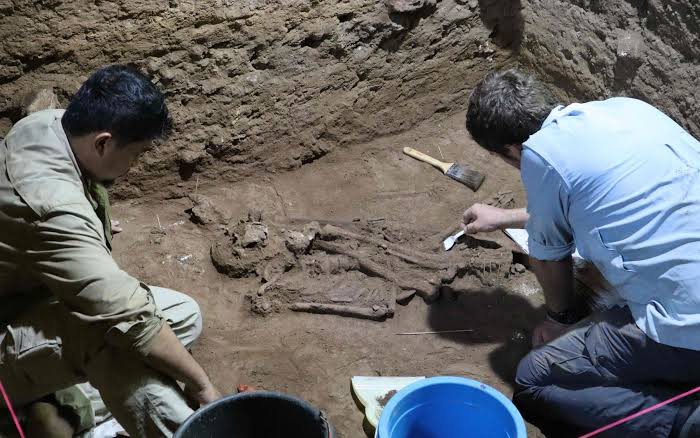Stone Age population having advanced medical expertise recent research exposes
The remains of a young person whose discovery by archaeologists could change the course of medical history were discovered buried in a shallow grave in a remote Indonesian cave.According to study published in the journal Nature on Wednesday, using radiocarbon dating methods, scientists estimate the body has been undiscovered for 31,000 years inside the Liang Tebo cave in eastern Kalimantan region of Borneo.The young individual was missing their lower left leg, which was the most startling element of the discovery, with indicators it had been expertly severed when the person was a pre-teen or early teen, before their death from unknown circumstances between 19 and 21, according to researchers.
The amputation, which is the earliest example in the archeological record and reveals considerable surgical skill, has shaken up our understanding of the sophistication of Stone Age humans. The otherwise remarkably intact skeleton was discovered by Australian and Indonesian archaeologists in 2020.Maxime Aubert, a professor at Griffith University's Centre for Social and Cultural Research in Queensland, stated through email that "it's significant because it significantly pushes back our species' knowledge about surgery and sophisticated medicine."
"They required in-depth understanding of human anatomy, blood flow control, anesthesia, and antisepsis. Only recently have all of these become commonplace, "Aubert composed.Prior to the advent of agriculture and permanent settlements, which have profoundly changed human society over the past 10,000 years, experts believed people lacked the knowledge necessary to conduct complex surgeries like amputation.Prior to this finding, an elderly farmer in what is now France who had his left forearm amputated just above the elbow 7,000 years ago was the oldest amputee known.
The Western medical standard for surgical amputation just emerged 100 years ago. According to the study, the majority of persons would have died at the time of amputation without advancements like antibiotics.Tim Maloney, a researcher at Griffith University and one of the study's co-authors, noted that, until very recently in human history, blood loss, shock, and subsequent infection were the main causes of amputation becoming lethal.
Public assistance
According to the study, the person who had their lower left leg amputated as a toddler lived for six to nine years following the procedure.The bones showed no signs of infection, and new bone development had developed over the severed area, which takes time. Additionally, the amputated bones ceased developing and remained kid size, but the rest of the skeleton had grown to adult size.
According to the study, the surgeon or surgeons who performed the procedure 31,000 years ago with knives and scalpels likely made of stone needed a thorough understanding of anatomy and the muscular and vascular systems to expose and navigate the veins, vessels, and nerves as well as prevent fatal blood loss and infection.Following the amputation, considerable nursing and care were required, and the wound required frequent cleaning and disinfection.
The fact that there is actual, concrete archaeological evidence for a high level of community care, in Maloney's opinion, is what is most astonishing.In a hilly area, the person would have need a lot of continual assistance and care from their group to survive for years with an amputated leg.Charlotte Roberts, a professor emeritus in the Department of Archaeology at the University of Durham in the UK, stated in a commentary that was published with the paper that it was "astonishing" that the child survived the treatment and is believed to have lived for many years afterward. She didn't participate in the study.
Roberts concurred with the conclusion that the leg had been severed on purpose because an accidental wound wouldn't have a neat, sloping incision. The fact that the person survived for years after the amputation and was respectfully buried further makes it unlikely that the foot was amputated as punishment, according to Roberts, an archaeologist who first trained as a nurse.The Australian researchers speculated that these hunters and gatherers would have been familiar with medical herbs that would have thrived in the Borneo jungle, such as antiseptics.
Thrilling Area for Discovery
A tooth was dated by detecting the radioactive decay of uranium isotopes, chemical elements contained in dental enamel, and the radiocarbon dating of charcoal remains in sediment layers above, at, and below the skeleton.The body was positioned in a flexed, fetal position, and a sizable ball of ocher, a mineral pigment used in Stone Age cave art, was placed on top of the burial. It is also the oldest known deliberate burial in Southeast Asian islands. Archeologist tells us more or equal to this in that there are depths of understanding hidden on all these and for the sake of much understanding and good deeds they have to be unraveled to prove much point.
The skeleton was found in an area that has emerged as a fascinating site for paleoanthropology: Liang Tebo, a sizable limestone cave with human hand stencils on the walls that is situated in a remote, hilly region and only accessible by boat at specific times of the year.In addition, extinct human species like the diminutive Homo floresiensis and Homo luzonensis have been discovered on islands in the same region, along with some of the world's oldest figurative rock art.
In the first successful big maritime voyage, mankind left from this region by boat to transverse Island South Asia and reach the Papuan and Australian continents, according to Aubert. Now that we know they possessed significant medical understanding, they were also accomplished artists.We found a 31,000-year-old prehistoric amputee at Liang Tebo less than a meter below the surface, and we know we still have another 3 to 4 meters of sediments to dig through before bedrock, he continued.
Alarm over the spread of Covid-19 ended the dig in 2020, and the Australian archaeologists hastened home to avoid border closures that would continue longer than two years."We cannot desire to return. More human remains could perhaps be discovered, as well as those of other species."
References
https://edition.cnn.com/2022/09/07/asia/earliest-amputation-borneo-scn/index.html




Hi @vickvan
Very interesting and instructive research. My respect to you!
Hola @vickvan
Muy interesante e instructiva investigación. Mi respeto para usted!
Thank you ma,thanks for stopping by
Congratulations @vickvan! You have completed the following achievement on the Hive blockchain and have been rewarded with new badge(s):
Your next payout target is 500 HP.
The unit is Hive Power equivalent because post and comment rewards can be split into HP and HBD
You can view your badges on your board and compare yourself to others in the Ranking
If you no longer want to receive notifications, reply to this comment with the word
STOPCheck out the last post from @hivebuzz:
Support the HiveBuzz project. Vote for our proposal!
There is reasonable evidence that this article has been spun, rewritten, or reworded from the source that you have provided. Spinning/rewriting full or partial texts with adding very little original are frowned upon by the community. Repeated spun posts could be considered fraud.
Fraud is discouraged by the community and may result in the account being Blacklisted.
If you believe this comment is in error, please contact us in #appeals in Discord.